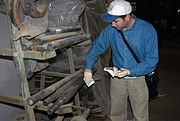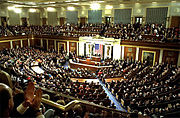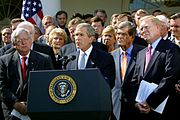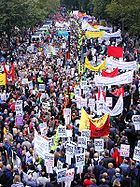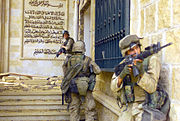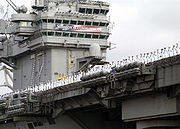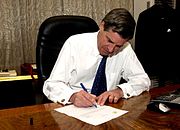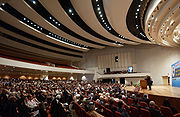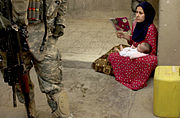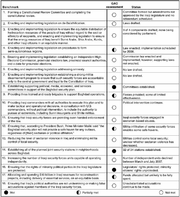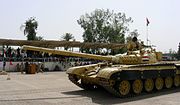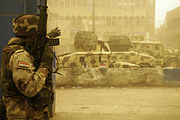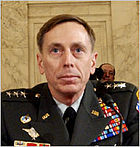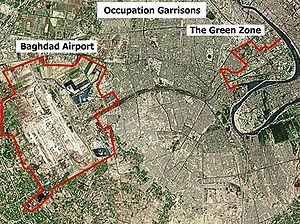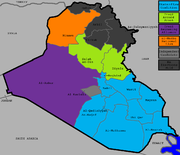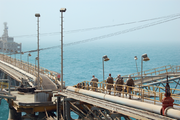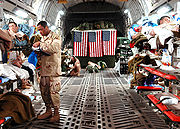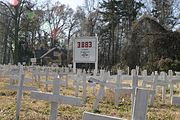
Iraq War
Did you know...
SOS believes education gives a better chance in life to children in the developing world too. Child sponsorship helps children one by one http://www.sponsor-a-child.org.uk/.
| Iraq War | |||||||
|---|---|---|---|---|---|---|---|
| Part of the Persian Gulf conflicts and War on Terror | |||||||
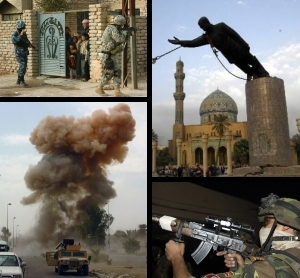 Clockwise, starting at top left: a joint patrol in Samarra; the toppling of the Saddam Hussein statue in Firdos Square; an Iraqi Army soldier readies his rifle during an assault; a roadside bomb detonates in South Baghdad. |
|||||||
|
|||||||
| Belligerents | |||||||
|
Insurgent groups:
For fighting between insurgent groups, see Civil war in Iraq. |
||||||
| Commanders and leaders | |||||||
|
(POW)
|
||||||
| Strength | |||||||
| Invasion Forces (2003–2004) ~300,000 United States Security contractors 6,000-7,000 (estimate) Turkish Armed Forces: ~3,000–10,000 (2008) |
Iraqi Army: 375,000 (disbanded in 2003) Sunni Insurgents |
||||||
| Casualties and losses | |||||||
| Iraqi Security Forces (post-Saddam) Killed: 16,595 Wounded: 40,000+ Wounded: 32,539+ (32,012 U.S., 315 UK, 212+ other) Injured/diseased/other medical:** 51,139 (47,541 U.S., 3,598 UK) Turkish Armed Forces: |
Iraqi combatant dead (invasion period): 13,500–45,000 Insurgents (post-Saddam) PKK: 230 killed (Turkish claim), 9 killed (PKK claim), 230 (official army figures claim) |
||||||
| Documented civilian deaths from violence, Iraq Body Count – 2003 through October 10, 2010: 98,380–107,369 recorded and 15,114 new deaths added from the Iraq War Logs Estimated excess deaths, (Lancet) – March 2003 - July 2006: 654,965 (95% CI: 392,979-942,636) Estimated violent deaths, Iraq Family Health Survey - March 2003 - July 2006: 151,000 (95% CI: 104,000-223,000) For more information see: Casualties of the Iraq War |
|||||||
| *Casualty numbers from the US Dept. of Labor for Contractors are combined for Iraq and Afghanistan. ** "injured, diseased, or other medical" – required medical air transport. UK number includes "aeromed evacuations" ***Total deaths include all additional deaths due to increased lawlessness, degraded infrastructure, poorer healthcare, etc. |
|||||||
|
|||||||||||||||
The Iraq War, Second Gulf War or Operation Iraqi Freedom was a military campaign that began on March 20, 2003, with the invasion of Iraq by a multinational force led by troops from the United States under the administration of President George W. Bush and the United Kingdom under Prime Minister Tony Blair.
Prior to the invasion, the governments of the United States and the United Kingdom asserted that the possibility of Iraq employing weapons of mass destruction (WMD) threatened their security and that of their coalition/regional allies. In 2002, the United Nations Security Council passed Resolution 1441 which called for Iraq to completely cooperate with UN weapon inspectors to verify that it was not in possession of weapons of mass destruction and cruise missiles. The United Nations Monitoring, Verification and Inspection Commission (UNMOVIC) was given access by Iraq under provisions of the UN resolution but found no evidence of weapons of mass destruction. Additional months of inspection to conclusively verify Iraq's compliance with the UN disarmament requirements were not undertaken. Head weapons inspector Hans Blix advised the UN Security Council that while Iraq's cooperation was "active", it was not "unconditional" not "immediate". Iraq's declarations with regards to weapons of mass destruction could not be verified at the time, but unresolved tasks concerning Iraq's disarmment could be completed in "not years, not weeks, but months".
Following the invasion, the U.S.-led Iraq Survey Group concluded that Iraq had ended its nuclear, chemical, and biological programs in 1991 and had no active programs at the time of the invasion but that Iraq intended to resume production once sanctions were lifted. Although some degraded remnants of misplaced or abandoned chemical weapons from before 1991 were found, they were not the weapons which had been the main argument to justify the invasion. Some U.S. officials also accused Iraqi President Saddam Hussein of harboring and supporting al-Qaeda, but no evidence of a meaningful connection was ever found. Other reasons for the invasion included Iraq's financial support for the families of Palestinian suicide bombers, Iraqi government human rights abuse, and an effort to spread democracy to the country.
The invasion of Iraq led to an occupation and the eventual capture of President Hussein, who was later tried in an Iraqi court of law and executed by the new Iraqi government. Violence against coalition forces and among various sectarian groups soon led to the Iraqi insurgency, strife between many Sunni and Shia Iraqi groups, and the emergence of a new faction of al-Qaeda in Iraq. In 2008, the UNHCR reported an estimate of 4.7 million refugees (~16% of the population) with 2 million abroad (a number close to CIA projections) and 2.7 million internally displaced people. In 2007, Iraq's anti-corruption board reported that 35% of Iraqi children, or about five million children, were orphans. The Red Cross stated in March 2008 that Iraq's humanitarian situation remained among the most critical in the world, with millions of Iraqis forced to rely on insufficient and poor-quality water sources.
In June 2008, U.S. Department of Defense officials claimed security and economic indicators began to show signs of improvement in what they hailed as significant and fragile gains. In 2007, Iraq was second on the Failed States Index; though its ranking has steadily improved since then, moving to fifth on the 2008 list, sixth in 2009, and seventh in 2010. As public opinion favoring troop withdrawals increased and as Iraqi forces began to take responsibility for security, member nations of the Coalition withdrew their forces. In late 2008, the U.S. and Iraqi governments approved a Status of Forces Agreement effective through January 1, 2012. The Iraqi Parliament also ratified a Strategic Framework Agreement with the U.S., aimed at ensuring cooperation in constitutional rights, threat deterrence, education, energy development, and other areas.
In late February 2009, newly elected U.S. President Barack Obama announced an 18-month withdrawal window for combat forces, with approximately 50,000 troops remaining in the country "to advise and train Iraqi security forces and to provide intelligence and surveillance". General Ray Odierno, the top U.S. military commander in Iraq, said he believes all U.S. troops will be out of the country by the end of 2011, while UK forces ended combat operations on April 30, 2009. Iraqi Prime Minister Nouri al-Maliki has said he supports the accelerated pullout of U.S. forces. In a speech at the Oval Office on 31 August 2010 Obama declared "the American combat mission in Iraq has ended. Operation Iraqi Freedom is over, and the Iraqi people now have lead responsibility for the security of their country." Beginning September 1, 2010, the American operational name for its involvement in Iraq changed from "Operation Iraqi Freedom" to "Operation New Dawn." The remaining 50,000 U.S. troops are now designated as "advise and assist brigades" assigned to non-combat operations while retaining the ability to revert to combat operations as necessary. Two combat aviation brigades also remain in Iraq.
2001–2003: Iraq disarmament crisis and pre-war intelligence
UN weapons inspections resume
The issue of Iraq's disarmament reached a crisis in 2002–2003, when Bush demanded a complete end to alleged Iraqi production of weapons of mass destruction and full compliance with UN Security Council Resolutions requiring UN weapons inspectors unfettered access to suspected weapons production facilities. The UN had prohibited Iraq from developing or possessing such weapons after the Gulf War and required Iraq to permit inspections confirming compliance. During inspections in 1999, Iraq alleged that UN inspectors included U.S. intelligence agents that supplied the U.S. with a direct feed of conversations between Iraqi security agencies as well as other information. This was confirmed by the New York Times and the Wall Street Journal.
During 2002, Bush repeatedly warned of military action unless inspections were allowed to progress unfettered. In accordance with UN Security Council Resolution 1441 Iraq reluctantly agreed to new inspections in late 2002. The weapons inspections did not uncover any WMD in Iraq. Shortly before the invasion Hans Blix, the lead weapons inspector, advised the UN Security Council that Iraq was cooperating with inspections and that the confirmation of disarmament through inspections could be achieved in a short period of time if Iraq remained cooperative.
Alleged weapons of mass destruction
Before the Gulf War, in 1990, Iraq had stockpiled 550 short tons (500 t) of yellowcake uranium at the Tuwaitha nuclear complex about 20 kilometres (12 mi) south of Baghdad. In late February 2002, the CIA sent former Ambassador Joseph Wilson to investigate reports (later found to be forgeries) that Iraq was attempting to purchase additional yellowcake from Niger. Wilson returned and informed the CIA that reports of yellowcake sales to Iraq were "unequivocally wrong." The Bush administration, however, continued to allege Iraq's attempts to obtain additional yellowcake were a justification for military action, most prominently in the January 2003, State of the Union address, in which President Bush declared that Iraq had sought uranium, citing British intelligence sources.
In response, Wilson wrote a critical New York Times op-ed piece in June 2003 stating that he had personally investigated claims of yellowcake purchases and believed them to be fraudulent. After Wilson's op-ed, Wilson's wife Valerie Plame was publicly identified as an undercover CIA analyst by a columnist. This led to a Justice Department investigation into the source of the leak.
On May 1, 2005, the " Downing Street memo" was published in The Sunday Times. It contained an overview of a secret July 23, 2002, meeting among British government, Ministry of Defence, and British intelligence figures who discussed the build-up to the Iraq war—including direct references to classified U.S. policy of the time. The memo stated, "Bush wanted to remove Saddam, through military action, justified by the conjunction of terrorism and WMD. But the intelligence and facts were being fixed around the policy."
The CIA had contacted Iraq's foreign minister, Naji Sabri, who was being paid by the French as an agent. Sabri informed them that Saddam had hidden poison gas among Sunni tribesmen, had ambitions for a nuclear program but that it was not active, and that no biological weapons were being produced or stockpiled, although research was underway. According to Sidney Blumenthal, George Tenet briefed Bush on September 18, 2002, that Sabri had informed them that Iraq did not have WMD. Bush dismissed this top-secret intelligence from Hussein's inner circle which was approved by two senior CIA officers. The information was never shared with Congress or CIA agents examining whether Saddam had such weapons.
In September 2002, the Bush administration, the CIA and the DIA said attempts by Iraq to acquire high-strength aluminium tubes that were prohibited under the UN monitoring program and which they said pointed to a clandestine effort to make centrifuges to enrich uranium for nuclear bombs. This analysis was opposed by the United States Department of Energy (DOE) and INR, which was significant because of DOE's expertise in such gas centrifuges and nuclear weapons programs. The DOE and INR argued that the Iraqi tubes were poorly suited for centrifuges, though it was technically possible with additional modification. A report released by the Institute for Science and International Security in 2002 reported that it was highly unlikely that the tubes could be used to enrich uranium.
An effort by the DOE to correct this detail in comments prepared for United States Secretary of State Colin Powell's UN appearance was rebuffed by the administration and Powell, in his address to the UN Security Council just before the war, referenced the aluminium tubes, stating that while experts disagreed on whether or not the tubes were destined for a centrifuge program, the specifications of the tubes were unusually tight. Powell later admitted he had presented what turned out to be an inaccurate case to the UN on Iraqi weapons, and the intelligence he was relying on was, in some cases, "deliberately misleading." Shortly after the United States presidential election, 2008, and the election of rival Democratic party nominee Barack Obama, president Bush admitted that "[my] biggest regret of all the presidency has to have been the intelligence failure in Iraq".
In December 2009, former Prime Minister Tony Blair stated that he "would still have thought it right to remove [Saddam Hussein]" regardless of whether Iraq possessed weapons of mass destruction or not.
Preparations for Iraq war
During 2002 the amount of ordnance used by British and American aircraft patrolling the no-fly zones of Iraq increased compared to the previous years and by August had "become a full air offensive". Tommy Franks, the allied commander, later stated that the bombing was designed to "degrade" the Iraqi air defense system before an invasion.
In October 2002, a few days before the U.S. Senate voted on the Joint Resolution to Authorize the Use of United States Armed Forces Against Iraq, about 75 senators were told in closed session that Iraq had the means of attacking the Eastern Seaboard of the U.S. with biological or chemical weapons delivered by unmanned aerial vehicles (UAVs.) On February 5, 2003, Colin Powell presented further evidence in his Iraqi WMD program presentation to the UN Security Council that UAVs were ready to be launched against the U.S. At the time, there was a vigorous dispute within the U.S. military and intelligence communities as to whether CIA conclusions about Iraqi UAVs were accurate and other intelligence agencies suggested that Iraq did not possess any offensive UAV capability, saying the few they had were designed for surveillance and intended for reconnaissance. The Senate voted to approve the Joint Resolution with the support of large bipartisan majorities on October 11, 2002, providing the Bush administration with a legal basis for the U.S. invasion under U.S. law.
The resolution granted the authorization by the Constitution of the United States and the United States Congress for the President to command the military to fight anti-United States violence. Citing the Iraq Liberation Act of 1998, the resolution reiterated that it should be the policy of the United States to remove the Hussein regime and promote a democratic replacement.
Chief UN weapons inspector Hans Blix remarked in January 2003 that "Iraq appears not to have come to a genuine acceptance—not even today—of the disarmament, which was demanded of it and which it needs to carry out to win the confidence of the world and to live in peace." Among other things he noted that 1,000 short tons (910 t) of chemical agent were unaccounted for, information on Iraq's VX nerve agent program was missing, and that "no convincing evidence" was presented for the destruction of 8,500 litres (1,900 imp gal; 2,200 US gal) of anthrax that had been declared.
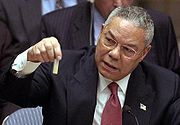
On February 5, 2003, Secretary of State Colin Powell appeared before the UN to present American evidence that Iraq was hiding unconventional weapons. The French government also believed that Saddam had stockpiles of anthrax and botulism toxin, and the ability to produce VX. In March, Blix said progress had been made in inspections, and no evidence of WMD had been found.
In early 2003, the U.S., British, and Spanish governments proposed the so-called "eighteenth resolution" to give Iraq a deadline for compliance with previous resolutions enforced by the threat of military action. This proposed resolution was subsequently withdrawn due to lack of support on the UN Security Council. In particular, North Atlantic Treaty Organization (NATO) members France, Germany and Canada and non-NATO member Russia were opposed to military intervention in Iraq, due to the high level of risk to the international community's security, and defended disarmament through diplomacy.
A meeting between George W. Bush and Tony Blair took place on January 31, 2003, in the White House. A secret memo of this meeting purportedly showed that the Bush administration had already decided on the invasion of Iraq at that point. Bush was allegedly floating the idea of painting a U-2 spyplane in UN colors and letting it fly low over Iraq to provoke Iraqi forces into shooting it down, thereby providing a pretext for the U.S. and Britain to invade. Bush and Blair made a secret deal to carry out the invasion regardless of whether WMD were discovered by UN weapons inspectors, in direct contradiction with statements Blair made to the British House of Commons afterwards that the Iraqi regime would be given a final chance to disarm. In the memo, Bush is paraphrased as saying, "The start date for the military campaign was now pencilled in for 10 March. This was when the bombing would begin." Bush said to Blair that he "thought it unlikely that there would be internecine warfare between the different religious and ethnic groups" in Iraq after the war.
Opposition to invasion
In October 2002 former U.S. President Bill Clinton warned about possible dangers of pre-emptive military action against Iraq. Speaking in the UK on a Labour Party conference he said: "As a preemptive action today, however well-justified, may come back with unwelcome consequences in the future. And because I don't care – and I've done this. I've ordered these kinds of actions. I don't care how precise your bombs and your weapons are, when you set them off, innocent people will die."
On January 20, 2003, French Foreign Minister Dominique de Villepin declared "we believe that military intervention would be the worst solution." Meanwhile anti-war groups across the world organised public protests. According to French academic Dominique Reynié, between January 3 and April 12, 2003, 36 million people across the globe took part in almost 3,000 protests against war in Iraq, with demonstrations on February 15, 2003, being the largest and most prolific.
In February 2003, the U.S. Army's top general, Eric Shinseki, told the Senate Armed Services Committee that it would take "several hundred thousand soldiers" to secure Iraq. Two days later, U.S. Defense Secretary Donald Rumsfeld said the post-war troop commitment would be less than the number of troops required to win the war, and that "the idea that it would take several hundred thousand U.S. forces is far from the mark." Deputy Defense Secretary Paul Wolfowitz said Shineski's estimate was "way off the mark," because other countries would take part in an occupying force.
In March 2003, Hans Blix reported that "No evidence of proscribed activities have so far been found" in Iraq, saying that progress was made in inspections which would continue. He estimated the time remaining for disarmament being verified through inspections to be "months". But the U.S. government announced that "diplomacy has failed", and that it would proceed with a coalition of allied countries—named the " coalition of the willing"—to rid Iraq of its alleged WMD. The U.S. government abruptly advised UN weapons inspectors to leave Baghdad immediately.
There were serious legal questions surrounding the launching of the war against Iraq and the Bush Doctrine of preemptive war in general. On September 16, 2004, Kofi Annan, the Secretary General of the United Nations, said of the invasion, "I have indicated it was not in conformity with the UN Charter. From our point of view, from the Charter point of view, it was illegal."
In November 2008 Lord Bingham, the former British Law Lord, described the war a serious violation of international law, and accused Britain and the U.S. of acting like a "world vigilante". He also criticized the post-invasion record of Britain as "an occupying power in Iraq". Regarding the treatment of Iraqi detainees in Abu Ghraib, Bingham said: "Particularly disturbing to proponents of the rule of law is the cynical lack of concern for international legality among some top officials in the Bush administration." In July 2010, Deputy Prime Minister of the UK Nick Clegg, in an official PMQs session in Parliament, condemned the invasion of Iraq as illegal. Theorist Francis Fukuyama has argued that "the Iraq war and the close association it created between military invasion and democracy promotion tarnished the latter".
2003: Invasion
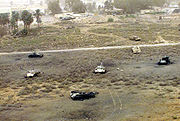
The first Central Intelligence Agency invasion team entered Iraq on July 10, 2002. This team was composed of members of the CIA's Special Activities Division and was later joined by members of the U.S. military's elite Joint Special Operations Command (JSOC). Together, they prepared for the invasion of conventional forces. These efforts consisted of persuading the commanders of several Iraqi military divisions to surrender rather than oppose the invasion, and to identify all of the initial leadership targets during very high risk reconnaissance missions.
Most importantly, their efforts organized the Kurdish Peshmerga to become the northern front of the invasion. Together this force defeated Ansar al-Islam in Iraqi Kurdistan before the invasion and then defeated the Iraqi army in the north. The battle against Ansar al-Islam led to the death of a substantial number of militants and the uncovering of a chemical weapons facility at Sargat.
At 5:34 a.m. Baghdad time on March 20, 2003 (9:34 p.m., March 19 EST) the military invasion of Iraq began. The 2003 invasion of Iraq, led by U.S. army General Tommy Franks, began under the codename "Operation Iraqi Liberation", later renamed "Operation Iraqi Freedom", the UK codename Operation Telic, and the Australian codename Operation Falconer. Coalition forces also cooperated with Kurdish Peshmerga forces in the north. Approximately forty other governments, the " U.S.-led coalition against Iraq," participated by providing troops, equipment, services, security, and special forces, with 248,000 soldiers from the United States, 45,000 British soldiers, 2,000 Australian soldiers and 194 Polish soldiers from Special Forces unit GROM sent to Kuwait for the invasion. The invasion force was also supported by Iraqi Kurdish militia troops, estimated to number upwards of 70,000.
The stated objectives of the invasion were; end the Hussein regime; eliminate whatever weapons of mass destruction could be found; eliminate whatever Islamist militants could be found; obtain intelligence on militant networks; distribute humanitarian aid; secure Iraq's petroleum infrastructure; and assist in creating a representative but compliant government as a model for other Middle East nations.
The invasion was a quick and decisive operation encountering major resistance, though not what the U.S., British and other forces expected. The Iraqi regime had prepared to fight both a conventional and irregular war at the same time, conceding territory when faced with superior conventional forces, largely armored, but launching smaller scale attacks in the rear using fighters dressed in civilian and paramilitary clothes. This achieved some temporary successes and created unexpected challenges for the invading forces, especially the U.S. military.
Coalition troops launched air and amphibious assault on the Al-Faw peninsula to secure the oil fields there and the important ports, supported by warships of the Royal Navy, Polish Navy, and Royal Australian Navy. The United States Marine Corps' 15th Marine Expeditionary Unit, attached to 3 Commando Brigade and the Polish Special Forces unit GROM attacked the port of Umm Qasr, while the British Army's 16 Air Assault Brigade secured the oilfields in southern Iraq. Polish commandos captured offshore oil platforms near the port, preventing their destruction.
The heavy armor of the U.S. 3rd Infantry Division moved westward and then northward through the western desert toward Baghdad, while the 1st Marine Expeditionary Force moved more easterly along Highway 1 through the centre of the country, and 1 (UK) Armoured Division moved northward through the eastern marshland. The U.S. 1st Marine Division fought through Nasiriyah in a battle to seize the major road junction and nearby Talil Airfield. The United States Army 3rd Infantry Division defeated Iraqi forces entrenched in and around the airfield and bypassed the city to the west in its drive up north through western Iraq.
With the Nasiriyah and Talil Airfields secured in its rear, the 3rd Infantry Division supported by 101st Airborne Division continued its attack north toward Najaf and Karbala, but a severe sand storm slowed the coalition advance and there was a halt to consolidate and make sure the supply lines were secure. When they started again they secured the Karbala Gap, a key approach to Baghdad, then forced the bridges over Euphrates River and the American forces poured through gap on to Baghdad. In the middle of Iraq, the 1st Marine Division fought its way to the eastern side of Baghdad, and prepared for the attack into Badhdad to seize it.
In the north, OIF-1 used the largest special operations force since the successful attack on the Taliban government of Afghanistan just over a year earlier. The Iraqi army was quickly overwhelmed in each engagement it faced with U.S. forces, with the elite Fedayeen Saddam putting up strong, sometimes suicidal, resistance before melting away into the civilian population.
On April 9 Baghdad fell, ending President Hussein's 24-year rule. U.S. forces seized the deserted Ba'ath Party ministries and stage-managed the tearing down of a huge iron statue of Hussein, photos and video of which became symbolic of the event, although later controversial. Not seen in the photos or heard on the videos, shot with a zoom lens, was the chant of the inflamed crowd for al-Sadr, the radical Shiite cleric. In November 2008, Iraqi protesters staged a similar stomping on and burning of an effigy of George W. Bush. The abrupt fall of Baghdad was accompanied by a widespread outpouring of gratitude toward the invaders, but also massive civil disorder, including the looting of public and government buildings and drastically increased crime.
According to the Pentagon, 250,000 short tons (230,000 t) (of 650,000 short tons (590,000 t) total) of ordnance was looted, providing a significant source of ammunition for the Iraqi insurgency. The invasion phase concluded when Tikrit, Hussein's home town, fell with little resistance to the U.S. Marines of Task Force Tripoli and on April 15 the coalition declared the invasion effectively over.
In the invasion phase of the war (March 19-April 30), 9,200 Iraqi combatants were killed along with 7,299 civilians, primarily by U.S. air and ground forces. Coalition forces reported the death in combat of 139 U.S. military personnel and 33 UK military personnel.
Coalition Provisional Authority and Iraq Survey Group
Shortly after the invasion, which has resulted in the debellatio of Iraq, the multinational coalition created the Coalition Provisional Authority (CPA) سلطة الائتلاف الموحدة, based in the Green Zone, as a transitional government of Iraq until the establishment of a democratic government. Citing United Nations Security Council Resolution 1483 (May 22, 2003) and the laws of war, the CPA vested itself with executive, legislative, and judicial authority over the Iraqi government from the period of the CPA's inception on April 21, 2003, until its dissolution on June 28, 2004.
The CPA was originally headed by Jay Garner, a former U.S. military officer, but his appointment lasted only until May 11, 2003, when President Bush appointed L. Paul Bremer. Bremer served until the CPA's dissolution in July 2004.
Another group created by the multinational force in Iraq post-invasion was the 1,400-member international Iraq Survey Group who conducted a fact-finding mission to find Iraqi weapons of mass destruction (WMD) programmes. In 2004 the ISG's Duelfer Report stated that Iraq did not have a viable WMD program.
Post-invasion phase
On May 1, 2003, President Bush staged a dramatic visit to the aircraft carrier USS Abraham Lincoln operating a few miles west of San Diego, California. The visit climaxed at sunset with Bush's now well-known " Mission Accomplished" speech. In this nationally televised speech, delivered before the sailors and airmen on the flight deck, Bush effectively declared victory due to the defeat of Iraq's conventional forces. However, former President Hussein remained at large and significant pockets of resistance remained.
After President Bush's speech, coalition forces noticed a gradually increasing flurry of attacks on its troops in various regions, especially in the " Sunni Triangle". The initial Iraqi insurgents were supplied by hundreds of weapons caches created before the invasion by the Iraqi army and Republican Guard.
Initially, Iraqi resistance (described by the coalition as "Anti-Iraqi Forces") largely stemmed from fedayeen and Hussein/ Ba'ath Party loyalists, but soon religious radicals and Iraqis angered by the occupation contributed to the insurgency. The three provinces with the highest number of attacks were Baghdad, Al Anbar, and Salah Ad Din. Those three provinces account for 35% of the population, but are responsible for 73% of U.S. military deaths (as of December 5, 2006), and an even higher percentage of recent U.S. military deaths (about 80%.)
Insurgents use guerrilla tactics including: mortars, missiles, suicide attacks, snipers, improvised explosive devices (IEDs), car bombs, small arms fire (usually with assault rifles), and RPGs ( rocket propelled grenades), as well as sabotage against the petroleum, water, and electrical infrastructure.
Post-invasion Iraq coalition efforts commenced after the fall of the Hussein regime. The coalition nations, together with the United Nations, began to work to establish a stable, compliant democratic state capable of defending itself from non-coalition forces, as well as overcoming internal divisions.
Meanwhile, coalition military forces launched several operations around the Tigris River peninsula and in the Sunni Triangle. A series of similar operations were launched throughout the summer in the Sunni Triangle. Toward the end of 2003, the intensity and pace of insurgent attacks began to increase. A sharp surge in guerrilla attacks ushered in an insurgent effort that was termed the " Ramadan Offensive", as it coincided with the beginning of the Muslim holy month of Ramadan.
To counter this offensive, coalition forces begin to use air power and artillery again for the first time since the end of the invasion by striking suspected ambush sites and mortar launching positions. Surveillance of major routes, patrols, and raids on suspected insurgents were stepped up. In addition, two villages, including Hussein's birthplace of al-Auja and the small town of Abu Hishma were surrounded by barbed wire and carefully monitored.
Hunting down the Hussein regime
In the summer of 2003, the multinational forces focused on hunting down the remaining leaders of the former regime. On July 22, a raid by the U.S. 101st Airborne Division and soldiers from Task Force 20 killed Hussein's sons ( Uday and Qusay) along with one of his grandsons. In all, over 300 top leaders of the former regime were killed or captured, as well as numerous lesser functionaries and military personnel.
Most significantly, Saddam Hussein himself was captured on December 13, 2003, on a farm near Tikrit in Operation Red Dawn. The operation was conducted by the United States Army's 4th Infantry Division and members of Task Force 121. Intelligence on Saddam's whereabouts came from his family members and former bodyguards.
With the capture of Hussein and a drop in the number of insurgent attacks, some concluded the multinational forces were prevailing in the fight against the insurgency. The provisional government began training the new Iraqi security forces intended to police the country, and the United States promised over $20 billion in reconstruction money in the form of credit against Iraq's future oil revenues. Oil revenue was also used for rebuilding schools and for work on the electrical and refining infrastructure.
Shortly after the capture of Hussein, elements left out of the Coalition Provisional Authority began to agitate for elections and the formation of an Iraqi Interim Government. Most prominent among these was the Shia cleric Grand Ayatollah Ali al-Sistani. The Coalition Provisional Authority opposed allowing democratic elections at this time. The insurgents stepped up their activities. The two most turbulent centers were the area around Fallujah and the poor Shia sections of cities from Baghdad ( Sadr City) to Basra in the south.
-
Polish GROM forces in sea operations during Operation Iraqi Freedom.
2004: Insurgency expands
- See also: Military operations of the Iraq War for a list of all Coalition operations for this period, 2004 in Iraq, Iraqi coalition counter-insurgency operations, History of Iraqi insurgency, United States occupation of Fallujah, Iraq Spring Fighting of 2004
The start of 2004 was marked by a relative lull in violence. Insurgent forces reorganised during this time, studying the multinational forces' tactics and planning a renewed offensive. However, violence did increase during the Iraq Spring Fighting of 2004 with foreign fighters from around the Middle East as well as al-Qaeda in Iraq (an affiliated al-Qaeda group), led by Abu Musab al-Zarqawi helping to drive the insurgency.
As the insurgency grew there was a distinct change in targeting from the coalition forces towards the new Iraqi Security Forces, as hundreds of Iraqi civilians and police were killed over the next few months in a series of massive bombings. An organized Sunni insurgency, with deep roots and both nationalist and Islamist motivations, was becoming more powerful throughout Iraq. The Shia Mahdi Army also began launching attacks on coalition targets in an attempt to seize control from Iraqi security forces. The southern and central portions of Iraq were beginning to erupt in urban guerrilla combat as multinational forces attempted to keep control and prepared for a counteroffensive.
The most serious fighting of the war so far began on March 31, 2004, when Iraqi insurgents in Fallujah ambushed a Blackwater USA convoy led by four U.S. private military contractors who were providing security for food caterers Eurest Support Services. The four armed contractors, Scott Helvenston, Jerko Zovko, Wesley Batalona, and Michael Teague, were killed with grenades and small arms fire. Subsequently, their bodies were dragged from their vehicles by local people, beaten, set ablaze, and their burned corpses hung over a bridge crossing the Euphrates. Photos of the event were released to news agencies worldwide, causing a great deal of indignation and moral outrage in the United States, and prompting an unsuccessful "pacification" of the city: the First Battle of Fallujah in April 2004.
The offensive was resumed in November 2004 in the bloodiest battle of the war so far: the Second Battle of Fallujah, described by the U.S. military as "the heaviest urban combat (that they had been involved in) since the battle of Hue City in Vietnam." During the assault, U.S. forces used white phosphorus as an incendiary weapon against insurgent personnel, attracting controversy. The 46-day battle resulted in a victory for the coalition, with 95 U.S. soldiers killed along with approximately 1,350 insurgents. Fallujah was totally devastated during the fighting, though civilian casualties were low, as they had mostly fled before the battle.
Another major event of that year was the revelation of widespread prisoner abuse at Abu Ghraib which received international media attention in April 2004. First reports of the Abu Ghraib prisoner abuse, as well as graphic pictures showing U.S. military personnel taunting and abusing Iraqi prisoners, came to public attention from a 60 Minutes II news report (April 28) and a Seymour M. Hersh article in The New Yorker (posted online on April 30.) Military correspondent Thomas Ricks claimed that these revelations dealt a blow to the moral justifications for the occupation in the eyes of many people, especially Iraqis, and was a turning point in the war.
2005: Elections and transitional government
On January 31, Iraqis elected the Iraqi Transitional Government in order to draft a permanent constitution. Although some violence and a widespread Sunni boycott marred the event, most of the eligible Kurd and Shia populace participated. On February 4, Paul Wolfowitz announced that 15,000 U.S. troops whose tours of duty had been extended in order to provide election security would be pulled out of Iraq by the next month. February to April proved to be relatively peaceful months compared to the carnage of November and January, with insurgent attacks averaging 30 a day from the prior average of 70.
Hopes for a quick end to the insurgency and a withdrawal of U.S. troops were dashed in May, Iraq's bloodiest month since the invasion. Suicide bombers, believed to be mainly disheartened Iraqi Sunni Arabs, Syrians and Saudis, tore through Iraq. Their targets were often Shia gatherings or civilian concentrations of Shias. As a result, over 700 Iraqi civilians died in that month, as well as 79 U.S. soldiers.
The summer of 2005 saw fighting around Baghdad and at Tall Afar in northwestern Iraq as U.S. forces tried to seal off the Syrian border. This led to fighting in the autumn in the small towns of the Euphrates valley between the capital and that border.
A referendum was held on October 15 in which the new Iraqi constitution was ratified. An Iraqi national assembly was elected in December, with participation from the Sunnis as well as the Kurds and Shia.
Insurgent attacks increased in 2005 with 34,131 recorded incidents, compared to a total 26,496 for the previous year.
2006: Civil war and permanent Iraqi government
The beginning of 2006 was marked by government creation talks, growing sectarian violence, and continuous anti-coalition attacks. Sectarian violence expanded to a new level of intensity following the al-Askari Mosque bombing in the Iraqi city of Samarra, on February 22, 2006. The explosion at the mosque, one of the holiest sites in Shi'a Islam, is believed to have been caused by a bomb planted by al-Qaeda.
Although no injuries occurred in the blast, the mosque was severely damaged and the bombing resulted in violence over the following days. Over 100 dead bodies with bullet holes were found on February 23, and at least 165 people are thought to have been killed. In the aftermath of this attack the U.S. military calculated that the average homicide rate in Baghdad tripled from 11 to 33 deaths per day. In 2006 the UN described the environment in Iraq as a "civil war-like situation."
On March 6, five United States Army soldiers of the 502nd Infantry Regiment, raped the 14-year-old Iraqi girl Abeer Hamza al-Janabi, and then murdered her, her father, her mother Fakhriya Taha Muhasen and her six-year-old sister. The soldiers then set fire to the girls body to conceal evidence of the crime. Four of the soldiers were convicted of rape and murder and the fifth was convicted of lesser crimes for the involvement in the war crime, that became known as the Mahmudiyah killings.
The current government of Iraq took office on May 20, 2006, following approval by the members of the Iraqi National Assembly. This followed the general election in December 2005. The government succeeded the Iraqi Transitional Government which had continued in office in a caretaker capacity until the formation of the permanent government.
Iraq Study Group report and Hussein's execution

The ISG was led by co-chairs James Baker, a former Secretary of State (Republican), and Lee Hamilton, a former U.S. Representative (Democrat).
The Iraq Study Group Report was released on December 6, 2006. Iraq Study Group, made up of people from both of the major U.S. parties, was led by former U.S. Secretary of State James Baker and former Democratic congressman Lee Hamilton. It concluded that "the situation in Iraq is grave and deteriorating" and "U.S. forces seem to be caught in a mission that has no foreseeable end." The report's 79 recommendations include increasing diplomatic measures with Iran and Syria and intensifying efforts to train Iraqi troops. On December 18, a Pentagon report found that insurgent attacks were averaging about 960 a week, the highest since the reports had begun in 2005.
Coalition forces formally transferred control of a province to the Iraqi government, the first since the war. Military prosecutors charged eight U.S. Marines with the murders of 24 Iraqi civilians in Haditha in November 2005, 10 of them women and children. Four officers were also charged with dereliction of duty in relation to the event.
Saddam Hussein was hanged on December 30, 2006, after being found guilty of crimes against humanity by an Iraqi court after a year-long trial.
2007: U.S. troop surge
In a January 10, 2007, televised address to the U.S. public, Bush proposed 21,500 more troops for Iraq, a job program for Iraqis, more reconstruction proposals, and $1.2 billion for these programs. On January 23, 2007, in the 2007 State of the Union Address, Bush announced "deploying reinforcements of more than 20,000 additional soldiers and Marines to Iraq."
On February 10, 2007, David Petraeus was made commander of Multi-National Force – Iraq (MNF-I), the four-star post that oversees all coalition forces in country, replacing General George Casey. In his new position, Petraeus oversaw all coalition forces in Iraq and employed them in the new "Surge" strategy outlined by the Bush administration. 2007 also saw a sharp increase in insurgent chlorine bombings.
On May 10, 2007, 144 Iraqi Parliamentary lawmakers signed onto a legislative petition calling on the United States to set a timetable for withdrawal. On June 3, 2007, the Iraqi Parliament voted 85 to 59 to require the Iraqi government to consult with Parliament before requesting additional extensions of the UN Security Council Mandate for Coalition operations in Iraq. Despite this, the mandate was renewed on December 18, 2007, without the approval of the Iraqi parliament.
Pressures on U.S. troops were compounded by the continuing withdrawal of coalition forces. In early 2007, British Prime Minister Blair announced that following Operation Sinbad British troops would begin to withdraw from Basra Governorate, handing security over to the Iraqis. In July Danish Prime Minister Anders Fogh Rasmussen also announced the withdrawal of 441 Danish troops from Iraq, leaving only a unit of nine soldiers manning four observational helicopters.
Planned troop reduction
In a speech made to Congress on September 10, 2007, Petraeus "envisioned the withdrawal of roughly 30,000 U.S. troops by next summer, beginning with a Marine contingent [in September]." On September 14, Bush backed a limited withdrawal of troops from Iraq. Bush said 5,700 personnel would be home by Christmas 2007, and expected thousands more to return by July 2008. The plan would take troop numbers back to their level before the surge at the beginning of 2007.
Effects of the surge on security
By March 2008, violence in Iraq was reported curtailed by 40–80%, according to a Pentagon report. Independent reports raised questions about those assessments. An Iraqi military spokesman claimed that civilian deaths since the start of the troop surge plan were 265 in Baghdad, down from 1,440 in the four previous weeks. The New York Times counted more than 450 Iraqi civilians killed during the same 28-day period, based on initial daily reports from Iraqi Interior Ministry and hospital officials.
Historically, the daily counts tallied by the NYT have underestimated the total death toll by 50% or more when compared to studies by the United Nations, which rely upon figures from the Iraqi Health Ministry and morgue figures.
The rate of U.S. combat deaths in Baghdad nearly doubled to 3.14 per day in the first seven weeks of the "surge" in security activity, compared to previous period. Across the rest of Iraq it reduced slightly.
On August 14, 2007, the deadliest single attack of the whole war occurred. Nearly 800 civilians were killed by a series of coordinated suicide bomb attacks on the northern Iraqi settlement of Qahtaniya. More than 100 homes and shops were destroyed in the blasts. U.S. officials blamed al-Qaeda. The targeted villagers belonged to the non-Muslim Yazidi ethnic minority. The attack may have represented the latest in a feud that erupted earlier that year when members of the Yazidi community stoned to death a teenage girl called Du'a Khalil Aswad accused of dating a Sunni Arab man and converting to Islam. The killing of the girl was recorded on camera-mobiles and the video was uploaded onto the internet
On September 13, 2007, Abdul Sattar Abu Risha was killed in a bomb attack in the city of Ramadi. He was an important U.S. ally because he led the " Anbar Awakening", an alliance of Sunni Arab tribes that opposed al-Qaeda. The latter organisation claimed responsibility for the attack. A statement posted on the Internet by the shadowy Islamic State of Iraq called Abu Risha "one of the dogs of Bush" and described Thursday's killing as a "heroic operation that took over a month to prepare".
There was a reported trend of decreasing U.S. troop deaths after May 2007, and violence against coalition troops had fallen to the "lowest levels since the first year of the American invasion". These, and several other positive developments, were attributed to the surge by many analysts.
Data from the Pentagon and other U.S. agencies such as the Government Accountability Office (GAO) found that daily attacks against civilians in Iraq remained "about the same" since February. The GAO also stated that there was no discernible trend in sectarian violence. However, this report ran counter to reports to Congress, which showed a general downward trend in civilian deaths and ethno-sectarian violence since December 2006. By late 2007, as the U.S. troop surge began to wind down, violence in Iraq had begun to decrease from its 2006 highs.
Entire neighborhoods in Baghdad were ethnically cleansed by Shia and Sunni militias and sectarian violence has broken out in every Iraqi city where there is a mixed population. Investigative reporter Bob Woodward cites U.S. government sources according to which the U.S. "surge" was not the primary reason for the drop in violence in 2007–2008. Instead, according to that view, the reduction of violence was due to newer covert techniques by U.S. military and intelligence officials to find, target and kill insurgents, including working closely with former insurgents.
In the Shia region near Basra, British forces turned over security for the region to Iraqi Security Forces. Basra is the ninth province of Iraq's 18 provinces to be returned to local security forces' control since the beginning of the occupation.
Political developments
More than half of the members of Iraq's parliament rejected the continuing occupation of their country for the first time. 144 of the 275 lawmakers signed onto a legislative petition that would require the Iraqi government to seek approval from Parliament before it requests an extension of the UN mandate for foreign forces to be in Iraq, which expires at the end of 2008. It also calls for a timetable for troop withdrawal and a freeze on the size of foreign forces. The UN Security Council mandate for U.S.-led forces in Iraq will terminate "if requested by the government of Iraq." Under Iraqi law, the speaker must present a resolution called for by a majority of lawmakers. 59% of those polled in the U.S. support a timetable for withdrawal.
In mid-2007, the Coalition began a controversial program to recruit Iraqi Sunnis (often former insurgents) for the formation of "Guardian" militias. These Guardian militias are intended to support and secure various Sunni neighborhoods against the Islamists.
Tensions with Iran
In 2007, tensions increased greatly between Iran and Iraqi Kurdistan due to the latter's giving sanctuary to the militant Kurdish secessionist group Party for a Free Life in Kurdistan (PEJAK.) According to reports, Iran had been shelling PEJAK positions in Iraqi Kurdistan since August 16. These tensions further increased with an alleged border incursion on August 23 by Iranian troops who attacked several Kurdish villages killing an unknown number of civilians and militants.
Coalition forces also began to target alleged Iranian Quds force operatives in Iraq, either arresting or killing suspected members. The Bush administration and coalition leaders began to publicly state that Iran was supplying weapons, particularly EFP devices, to Iraqi insurgents and militias although to date have failed to provide any proof for these allegations. Further sanctions on Iranian organizations were also announced by the Bush administration in the autumn of 2007. On November 21, 2007, Lieutenant General James Dubik, who is in charge of training Iraqi security forces, praised Iran for its "contribution to the reduction of violence" in Iraq by upholding its pledge to stop the flow of weapons, explosives and training of extremists in Iraq.
Tensions with Turkey
Border incursions by PKK militants based in Iraqi Kurdistan have continued to harass Turkish forces, with casualties on both sides increasing tensions between Turkey, a NATO member, and Iraqi Kurdistan. On an interview the PKK leader said that turkey does not come because of them, but because they do not want stability in the region.
In the fall of 2007, the Turkish military stated their right to cross the Iraqi Kurdistan border in "hot pursuit" of PKK militants and began shelling Kurdish areas in Iraq and attacking PKK bases in the Mount Cudi region with aircraft. The Turkish parliament approved a resolution permitting the military to pursue the PKK in Iraqi Kurdistan. In November, Turkish gunships attacked parts of northern Iraq in the first such attack by Turkish aircraft since the border tensions escalated. Another series of attacks in mid-December hit PKK targets in the Qandil, Zap, Avashin and Hakurk regions. The latest series of attacks involved at least 50 aircraft and artillery and Kurdish officials reported one civilian killed and two wounded.
Additionally, weapons that were given to Iraqi security forces by the U.S. military are being recovered by authorities in Turkey after being used in that state.
Private security firm controversy
On September 17, 2007, the Iraqi government announced that it was revoking the license of the U.S. security firm Blackwater USA over the firm's involvement in the killing of eight civilians, including a woman and an infant, in a firefight that followed a car bomb explosion near a State Department motorcade.
2008: Iraqi forces arm
Throughout 2008, U.S. officials and independent think tanks began to point to improvements in the security situation, as measured by key statistics. According to the U.S. Defense Department, in December 2008 the "overall level of violence" in the country had dropped 80% since before the surge began in January 2007, and the country's murder rate had dropped to pre-war levels. They also pointed out that the casualty figure for U.S. forces in 2008 was 314 against a figure of 904 in 2007.
According to the Brookings Institution, Iraqi civilian fatalities numbered 490 in November 2008 as against 3,500 in January 2007, whereas attacks against the coalition numbered somewhere between 200 and 300 per week in the latter half of 2008, as opposed to a peak of nearly 1,600 in summer 2007. The number of Iraqi security forces killed was under 100 per month in the second half of 2008, from a high of 200 to 300 in summer 2007.
Meanwhile, the proficiency of the Iraqi military increased as it launched a spring offensive against Shia militias which Prime Minister Nouri al-Maliki had previously been criticized for allowing to operate. This began with a March operation against the Mehdi Army in Basra, which led to fighting in Shia areas up and down the country, especially in the Sadr City district of Baghdad. By October, the British officer in charge of Basra said that since the operation the town had become "secure" and had a murder rate comparable to Manchester in England. The U.S. military also said there had been a decrease of about a quarter in the quantity of Iranian-made explosives found in Iraq in 2008, possibly indicating a change in Iranian policy.
Progress in Sunni areas continued after members of the Awakening movement were transferred from U.S. military to Iraqi control. In May, the Iraqi army – backed by coalition support – launched an offensive in Mosul, the last major Iraqi stronghold of al-Qaeda. Despite detaining thousands of individuals, the offensive failed to lead to major long-term security improvements in Mosul. At the end of the year, the city remained a major flashpoint.
In the regional dimension, the ongoing conflict between Turkey and PKK intensified on February 21, when Turkey launched a ground attack into the Quandeel Mountains of Northern Iraq. In the nine day long operation, around 10,000 Turkish troops advanced up to 25 km into Northern Iraq. This was the first substantial ground incursion by Turkish forces since 1995.
Shortly after the incursion began, both the Iraqi cabinet and the Kurdistan regional government condemned Turkey's actions and called for the immediate withdrawal of Turkish troops from the region. Turkish troops withdrew on February 29. The fate of the Kurds and the future of the ethnically diverse city of Kirkuk remained a contentious issue in Iraqi politics.
U.S. military officials met these trends with cautious optimism as they approached what they described as the "transition" embodied in the U.S.-Iraq Status of Forces Agreement which was negotiated throughout 2008. The commander of the coalition, U.S. General Raymond T. Odierno, noted that "in military terms, transitions are the most dangerous time" in December 2008.
Spring offensives on Shia militias
At the end of March, the Iraqi Army, with Coalition air support, launched an offensive, dubbed "Charge of the Knights", in Basra to secure the area from militias. This was the first major operation where the Iraqi Army did not have direct combat support from conventional coalition ground troops. The offensive was opposed by the Mahdi Army, one of the militias, which controlled much of the region. Fighting quickly spread to other parts of Iraq: including Sadr City, Al Kut, Al Hillah and others. During the fighting Iraqi forces met stiff resistance from militiamen in Basra to the point that the Iraqi military offensive slowed to a crawl, with the high attrition rates finally forcing the Sadrists to the negotiating table.
Following talks with Brig. Gen. Qassem Suleimani, commander of the Qods brigades of Iran's Revolutionary Guard Corps, and the intercession of the Iranian government, on March 31, 2008, al-Sadr ordered his followers to ceasefire. The militiamen kept their weapons.
By May 12, 2008, Basra "residents overwhelmingly reported a substantial improvement in their everyday lives" according to The New York Times. "Government forces have now taken over Islamic militants' headquarters and halted the death squads and 'vice enforcers' who attacked women, Christians, musicians, alcohol sellers and anyone suspected of collaborating with Westerners", according to the report; however, when asked how long it would take for lawlessness to resume if the Iraqi army left, one resident replied, "one day".
In late April roadside bombings continued to rise from a low in January of 114 to over 250, surpassing the May 2007 high.
Congressional testimony
Speaking before the U.S. Congress on April 8, 2008, General David Petraeus urged delaying troop withdrawals, saying, "I've repeatedly noted that we haven't turned any corners, we haven't seen any lights at the end of the tunnel," referencing the comments of then President Bush and former Vietnam-era General William Westmoreland. When asked by the Senate if reasonable people could disagree on the way forward, Petraeus said, "We fight for the right of people to have other opinions."
Upon questioning by then Senate committee chair Joe Biden, Ambassador Crocker admitted that Al-Qaeda in Iraq was less important than the Al-Qaeda organization led by Osama bin Laden along the Afghan-Pakistani border. Lawmakers from both parties complained that U.S. taxpayers are carrying Iraq's burden as it earns billions of dollars in oil revenues.
Iraqi security forces rearm

Iraq became one of the top current purchasers of U.S. military equipment with their army trading its AK-47 assault rifles for the U.S. M-16 and M-4 rifles, among other equipment. In 2008 alone, Iraq accounted for more than $12.5 billion of the $34 billion U.S. weapon sales to foreign countries (not including the potential F-16 fighter planes.).
Iraq sought 36 F-16s, the most sophisticated weapons system Iraq has attempted to purchase. The Pentagon notified Congress that it had approved the sale of 24 American attack helicopters to Iraq, valued at as much as $2.4 billion. Including the helicopters, Iraq announced plans to purchase at least $10 billion in U.S. tanks and armored vehicles, transport planes and other battlefield equipment and services. Over the summer, the Defense Department announced that the Iraqi government wanted to order more than 400 armored vehicles and other equipment worth up to $3 billion, and six C-130J transport planes, worth up to $1.5 billion. From 2005 to 2008, the United States had completed approximately $20 billion in arms sales agreements with Iraq.
Status of forces agreement
The U.S.-Iraq Status of Forces Agreement was approved by the Iraqi government on December 4, 2008. It establishes that U.S. combat forces will withdraw from Iraqi cities by June 30, 2009, and that all U.S. forces will be completely out of Iraq by December 31, 2011. The pact is subject to possible negotiations which could delay withdrawal and a referendum scheduled for mid-2009 in Iraq which may require all U.S. forces to completely leave by the middle of 2010. The pact requires criminal charges for holding prisoners over 24 hours, and requires a warrant for searches of homes and buildings that are not related to combat.
U.S. contractors working for U.S. forces will be subject to Iraqi criminal law, while contractors working for the State Department and other U.S. agencies may retain their immunity. If U.S. forces commit still undecided "major premeditated felonies" while off-duty and off-base, they will be subject to the still undecided procedures laid out by a joint U.S.-Iraq committee if the U.S. certifies the forces were off-duty.
Some Americans have discussed "loopholes" and some Iraqis have said they believe parts of the pact remain a "mystery". U.S. Secretary of Defense Robert Gates has predicted that after 2011 he would expect to see "perhaps several tens of thousands of American troops" as part of a residual force in Iraq.
Several groups of Iraqis protested the passing of the SOFA accord as prolonging and legitimizing the occupation. Tens of thousands of Iraqis burned an effigy of George W. Bush in a central Baghdad square where U.S. troops five years previously organized a tearing down of a statue of Saddam Hussein. Some Iraqis expressed skeptical optimism that the U.S. would completely end its presence by 2011. On December 4, 2008, Iraq's presidential council approved the security pact.
A representative of Grand Ayatollah Ali Husseini al-Sistani's expressed concern with the ratified version of the pact and noted that the government of Iraq has no authority to control the transfer of occupier forces into and out of Iraq, no control of shipments, and that the pact grants the occupiers immunity from prosecution in Iraqi courts. He said that Iraqi rule in the country is not complete while the occupiers are present, but that ultimately the Iraqi people would judge the pact in a referendum. Thousands of Iraqi have gathered weekly after Friday prayers and shouted anti-U.S. and anti-Israeli slogans protesting the security pact between Baghdad and Washington. A protester said that despite the approval of the Interim Security pact, the Iraqi people would break it in a referendum next year.
2009: Coalition redeployment
Transfer of Green Zone
On January 1, 2009, the United States handed control of the Green Zone and Saddam Hussein's presidential palace to the Iraqi government in a ceremonial move described by the country's prime minister as a restoration of Iraq's sovereignty. Iraqi Prime Minister Nouri al-Maliki said he would propose January 1 be declared national "Sovereignty Day". "This palace is the symbol of Iraqi sovereignty and by restoring it, a real message is directed to all Iraqi people that Iraqi sovereignty has returned to its natural status," al-Maliki said.
The U.S. military attributed a decline in reported civilians deaths to several factors including the U.S.-led "troop surge", the growth of U.S.-funded Awakening Councils, and Shiite cleric Muqtada al-Sadr's call for his militia to abide by a cease fire.
Provincial elections
On January 31, 2009, Iraq held provincial elections. Provincial candidates and those close to them faced some political assassinations and attempted assassinations, and there was also some other violence related to the election.
Iraqi voter turnout failed to meet the original expectations which were set and was the lowest on record in Iraq, but U.S. Ambassador Ryan Crocker characterized the turnout as "large". Of those who turned out to vote, some groups complained of disenfranchisement and fraud. After the post-election curfew was lifted, some groups made threats about what would happen if they were unhappy with the results.
Exit strategy announcement
| Wikinews has related news: Obama sets deadline to withdraw troops from Iraq |
On February 27, 2009, United States President Barack Obama gave a speech at Marine Corps Base Camp Lejeune in the U.S. state of North Carolina announcing that the U.S. combat mission in Iraq would end by August 31, 2010. A "transitional force" of up to 50,000 troops tasked with training the Iraqi Security Forces, conducting counterterrorism operations, and providing general support may remain until the end of 2011, the president added.
The day before Obama's speech, Prime Minister of Iraq Nuri al-Maliki said at a press conference that the government of Iraq had "no worries" over the impending departure of U.S. forces and expressed confidence in the ability of the Iraqi Security Forces and police to maintain order without American military support.
Sixth anniversary protests
On April 9, 2009, the sixth anniversary of Baghdad's fall to coalition forces, tens of thousands of Iraqis thronged Baghdad to mark the sixth anniversary of the city's fall and to demand the immediate departure of coalition forces. The crowds of Iraqis stretched from the giant Sadr City slum in northeast Baghdad to the square around 5 km (3 miles) away, where protesters burned an effigy featuring the face of former U.S. President George W. Bush, who ordered the U.S.-led invasion of Iraq, and also the face of Saddam Shi'ites were brutally persecuted under Saddam's rule. There were also Sunni Muslims in the crowd. Police said many Sunnis, including prominent leaders such as a founding sheikh from the Sons of Iraq, took part.
Coalition forces withdraw
On April 30, 2009, the United Kingdom formally ended combat operations. Prime Minister Gordon Brown characterized the operation in Iraq as a "success story" because of UK troops' efforts. Britain handed control of Basra to the United States Armed Forces.
The withdrawal of U.S. forces began at the end of June, with 38 bases to be handed over to Iraqi forces. On June 29, 2009, U.S. forces withdrew from Baghdad. On November 30, 2009, Iraqi Interior Ministry officials reported that the civilian death toll in Iraq fell to its lowest level in November since the 2003 invasion.
Iraq awards oil contracts
On June 30 and December 11, 2009, the Iraqi ministry of oil awarded contracts to international oil companies for some of Iraq's many oil fields. The winning oil companies enter joint ventures with the Iraqi ministry of oil, and the terms of the awarded contracts include extraction of oil for a fixed fee of approximately $1.40 per barrel. The fees will only be paid once a production threshold set by the Iraqi ministry of oil is reached.
2010: U.S. drawdown and Operation New Dawn
U.S. withdrawal
On February 17, 2010, Secretary of Defense Robert Gates announced that as of September 1, 2010, the name "Operation Iraqi Freedom" would be replaced by "Operation New Dawn".
On 20 June, Iraq's Central Bank was bombed in an attack that left 15 people dead and brought much of downtown Baghdad to a standstill. The attack was claimed to have been carried out by the Islamic State of Iraq. This attack was followed by another attack on Iraq's Bank of Trade building that killed 26 and wounded 52 people.
In late August 2010, insurgents conducted a major attack with at least 12 car bombs simultaneously detonating from Mosul to Basra and killing at least 51. These attacks coincided with the U.S. plans for a withdrawal of combat troops.
| Wikinews has related news: U.S. combat forces pull out of Iraq |
The last U.S. combat brigades departed Iraq in the early morning of August 19, 2010. Convoys of U.S. troops had been moving out of Iraq to Kuwait for several days, and NBC News broadcast live from Iraq as the last convoy crossed the border. While all combat brigades left the country, an additional 50,000 personnel remained in the country to provide support for the Iraqi military. These troops are required to leave Iraq by 31 December 2011 under an agreement between the U.S. and Iraqi governments. State Dept. spokesman P.J. Crowley stated "We are ending the war.... but we are not ending our work in Iraq, We have a long-term commitment to Iraq."
On August 31, 2010, Obama announced the end of Operation Iraqi Freedom from the Oval Office. In his address, he covered his next year's plan for closing operations in Afghanistan, the role of the United States' soft power, the effect the war has had on the United States economy, and the legacy of American wars.
The United States has paid a huge price to put the future of Iraq in the hands of its people. We have sent our young men and women to make enormous sacrifices in Iraq, and spent vast resources abroad at a time of tight budgets at home. We have persevered because of a belief we share with the Iraqi people—a belief that out of the ashes of war, a new beginning could be born in this cradle of civilization. Through this remarkable chapter in the history of the United States and Iraq, we have met our responsibility. Now, it is time to turn the page.—President Obama's Address on Iraq, August 31, 2010
On the same day in Iraq, at a ceremony at one of Saddam Hussein's former residences at Al Faw Palace in Baghdad, a number of U.S. dignitaries spoke in a ceremony for television cameras, avoiding overtones of the triumphalism present in US announcements made earlier in the war. Vice President Joe Biden expressed concerns regarding the ongoing lack of progress in forming a new Iraqi government, saying of the Iraqi people that "they expect a government that reflects the results of the votes they cast." Gen. Ray Odierno stated that the new era "in no way signals the end of our commitment to the people of Iraq." Speaking in Ramadi earlier in the day, Gates said that U.S. forces "have accomplished something really quite extraordinary here, [but] how it all weighs in the balance over time I think remains to be seen." When asked by reporters if the seven year war was worth doing, Gates commented that "It really requires a historian's perspective in terms of what happens here in the long run." He noted the Iraq War "will always be clouded by how it began" in regards Saddam Hussein's supposed weapons of mass destruction, which were never confirmed to have existed. Gates continued, "This is one of the reasons that this war remains so controversial at home." On the same day Gen. Ray Odierno was replaced by Lloyd Austin as Commander of US forces in Iraq
However, there has been some controversy over whether the official declaration is accurate, with the issuance of a standards memo from the Associated Press stating "combat in Iraq is not over, and we should not uncritically repeat suggestions that it is, even if they come from senior officials."
Ongoing tensions
On September 7, 2010, two U.S. troops were killed and nine wounded in an incident at an Iraqi military base. The incident is under investigation by Iraqi and U.S. forces, but it is believed that an Iraqi soldier opened fire on U.S. forces.
According to reports from Iraq, hundreds of members of the Sunni Awakening Councils may have switched allegiance back to the Iraqi insurgency or al Qaeda.
Wikileaks disclosed 391,832 classified U.S. military documents on the Iraq War.
Approximately, 58 people were killed with another 40 wounded in an attack on the Sayidat al-Nejat church, a Chaldean Catholic church in Baghdad. Responsibility for the attack was claimed by the Islamic State in Iraq organization.
Coordinated attacks in primarily Shia areas struck throughout Baghdad on November 2, 2010, killing approximately 113 and wounding 250 with around 17 bombs.
Iraqi security forces transition towards self reliance
Preparing to buy 13 billion dollars worth of American arms, the Iraq Defense Ministry intends to transform the country's degraded conventional forces into a state-of-the-art military and become among the world’s biggest customers for American military arms and equipment. Part of the planned purchase includes M-1 tanks, the main battle tank for the U.S. military. Iraq wants to buy 140 of the tanks, and Iraqi crews have already started training on them. In addition to the $13 billion purchase, the Iraqis have requested 18 F-16 Falcon fighter jets as part of a $4.2 billion program that also includes aircraft training and maintenance, Raytheon AIM-9 Sidewinder air-to-air, heat-seeking missiles for dogfighting, laser-guided bombs and reconnaissance equipment. If approved by Congress, the first aircraft could arrive in spring 2013. Under the plan, the first 10 pilots would be trained in the U.S.
The Iraqi navy also inaugurated U.S.-built Swift Class patrol boat at Umm Qasr, Iraq's main port at the northern end of the gulf. Iraq is to take delivery of 14 more of these $20 million, 50-foot craft before U.S. forces depart. The high-speed vessels' main mission will be to protect the oil terminals at al-Basra and Khor al-Amiya through which some 1.7 million barrels a day are loaded into tankers for export. Two U.S.-built offshore support vessels, each costing $70 million, are expected to be delivered in 2011.
UN lifts restrictions on Iraq
In a move to legitimize the existing Iraqi government, the United Nations lifted the Saddam Hussein-era UN restrictions on Iraq. These included allowing Iraq to have a civilian nuclear program, permitting the participation of Iraq in international nuclear and chemical weapons treaties, as well as returning control of Iraq's oil and gas revenue to the government and ending the Oil-for-Food Programme.
2011
Moktada al-Sadr returned to Iraq in the holy city of Najaf to lead the Sadrist movement after being in exile since 2007.
On January 15, 2011, three American troops were killed in Iraq. One of the troops was killed on a military operation in central Iraq, while the other two troops were deliberately shot by one or two Iraqi soldiers during a training exercise.
Casualty estimates
For coalition death totals see the infobox at the top right. See also Casualties of the Iraq War, which has casualty numbers for coalition nations, contractors, non-Iraqi civilians, journalists, media helpers, aid workers, wounded, etc. The main article also gives explanations for the wide variation in estimates and counts, and shows many ways in which undercounting occurs. Casualty figures, especially Iraqi ones, are highly disputed. This section gives a brief overview.
There have been several attempts by the media, coalition governments and others to estimate the Iraqi casualties. The table below summarizes some of these estimates.
| Source | Iraqi casualties | March 2003 to ... |
|---|---|---|
| Iraq Family Health Survey | 151,000 violent deaths. | June 2006 |
| Lancet survey | 601,027 violent deaths out of 654,965 excess deaths. | June 2006 |
| Opinion Research Business survey | 1,033,000 violent deaths from the conflict. | August 2007 |
| Associated Press | 110,600 violent deaths. | April 2009 |
| Iraq Body Count | 113,494 – 122,483 violent civilian deaths from the conflict. (including new deaths added from the Iraq War Logs) | October 2010 |
Criticism and cost
The Bush Administration's rationale for the Iraq War has faced heavy criticism from an array of popular and official sources both inside and outside the United States, with many U.S. citizens finding many parallels with the Vietnam War. According to the Centre for Public Integrity, the Bush administration made a total of 935 false statements between 2001 and 2003 about Iraq's alleged threat to the United States.
Both proponents and opponents of the invasion have also criticized the prosecution of the war effort along a number of other lines. Most significantly, critics have assailed the U.S. and its allies for not devoting enough troops to the mission, not adequately planning for post-invasion Iraq, and for permitting and perpetrating widespread human rights abuses. As the war has progressed, critics have also railed against the high human and financial costs.
The court-martial of Ehren Watada, the first U.S. officer to refuse to serve in Iraq, ended in a mistrial because the Judge Advocate General's Corps would not consider the question of whether orders could be illegal. A federal district court judge ruled that Watada cannot face double jeopardy on three of his five charges, but abstained from ruling on whether the two remaining charges of conduct unbecoming an officer may still go forward.
Another criticism of the initial intelligence leading up to the Iraq war comes from a former CIA officer who described the Office of Special Plans as a group of ideologues who were dangerous to U.S. national security and a threat to world peace, and that the group lied and manipulated intelligence to further its agenda of removing Saddam. Subsequently, in 2008, the nonpartisan Centre for Public Integrity has enumerated a total of 935 false statements made by George W. Bush and six other top members of his administration in what it termed a "carefully launched campaign of misinformation" during the two year period following 9/11 attacks, in order to rally support for the invasion of Iraq.
The financial cost of the war has been more than £4.55 billion ($9 billion) to the UK, and over $845 billion to the U.S., with the total cost to the U.S. economy estimated at $3 trillion.
Criticisms include:
- Legality of the invasion
- Human casualties
- Insufficient post-invasion plans, in particular inadequate troop levels (a RAND study stated that 500,000 troops would be required for success)
- Financial costs with approximately $612 billion spent as of 4/09 the CBO has estimated the total cost of the war in Iraq to U.S. taxpayers will be around $1.9 trillion.
- Adverse effect on U.S.-led global "war on terror"
- Damage to U.S.' traditional alliances and influence in the region, especially Israel and Saudi Arabia.
- Endangerment and ethnic cleansing of religious and ethnic minorities
- Disruption of Iraqi oil production and related energy security concerns (the price of oil has quadrupled since 2002)
After President Barack Obama was inaugurated in 2009, some anti-war groups decided to stop protesting even though the war was still going on. Some of them decided to stop because they felt they should give the new President time to establish his administration, and others stopped because they believed that Obama would end the war.
A CNN report noted that the U.S. led interim government, the Coalition Provisional Authority lasting until 2004 in Iraq had lost $8,800,000,000 in the Development Fund for Iraq. An inspector general's report mentioned that "'Severe inefficiencies and poor management' by the Coalition Provisional Authority would leave no guarantee that the money was properly used," said Stuart W. Bowen Jr., director of the Office of the Special Inspector General for Iraq Reconstruction. "The CPA did not establish or implement sufficient managerial, financial and contractual controls to ensure that funds were used in a transparent manner."
Humanitarian crises
In December 2007, the Iraqi government reported that there were 5 million orphans in Iraq – nearly half of the country's children. Iraq's health has deteriorated to a level not seen since the 1950s, said Joseph Chamie, former director of the UN Population Division and an Iraq specialist. "They were at the forefront", he said, referring to health care just before the 1991 Persian Gulf War. "Now they're looking more and more like a country in sub-Saharan Africa."
Malnutrition rates have risen from 19% before the U.S.-led invasion to a national average of 28% four years later. Some 60–70% of Iraqi children are suffering from psychological problems. 68% of Iraqis have no access to safe drinking water. A cholera outbreak in northern Iraq is thought to be the result of poor water quality. As many as half of Iraqi doctors have left the country since 2003.
Human rights abuses
Throughout the entire Iraq war there have been human rights abuses on all sides of the conflict.
Iraqi government
- The use of torture by Iraqi security forces.
- Iraqi police from the Interior Ministry accused of forming Death Squads and committing numerous massacres and tortures of Sunni Arabs and the police collusion with militias in Iraq have compounded the problems.
Coalition forces and private contractors
- Abu Ghraib torture and prisoner abuse
- Haditha killings of 24 civilians (ongoing with some charges dropped)
- White phosphorus use in Iraq
- Gang-rape and murder of a 14-year-old girl and the murder of her family, in Mahmoudiyah
- The torture and killing of prisoner of war, Iraqi Air Force commander, Abed Hamed Mowhoush
- Bombing and shooting of 42 civilians at a wedding party in Mukaradeeb
- Controversy over whether disproportionate force was used, during the assaults by Coalition and (mostly Shia and Kurdish) Iraqi government forces on the Sunni insurgent stronghold of Fallujah in 2004.
- Planting weapons on noncombatant, unarmed Iraqis by three U.S. Marines after killing them. According to a report by The Nation, other similar acts have been witnessed by U.S. soldiers. Members of Iraq Veterans Against the War tell similar stories.
Insurgent groups
- Killing over 12,000 Iraqis from January 2005 to June 2006, according to Iraqi Interior Minister Bayan Jabr, giving the first official count for the victims of bombings, ambushes and other deadly attacks. The insurgents have also conducted numerous suicide attacks on the Iraqi civilian population, mostly targeting the majority Shia community. An October 2005 report from Human Rights Watch examines the range of civilian attacks and their purported justification.
- Attacks against civilians including children through bombing of market places and other locations reachable by car bombs.
- Attacks on diplomats and diplomatic facilities including; the bombing of the UN headquarters in Baghdad in August 2003 killing the top UN representative in Iraq and 21 other UN staff members; beheading several diplomats: two Algerian diplomatic envoys Ali Belaroussi and Azzedine Belkadi, Egyptian diplomatic envoy al-Sherif, and four Russian diplomats.
- The February 2006 bombing of the al-Askari Mosque, destroying one of the holiest Shiite shrines, killing over 165 worshipers and igniting sectarian strife and reprisal killings.
- The publicised killing of several contractors; Eugene Armstrong, Jack Hensley, Kenneth Bigley, Ivaylo Kepov and Georgi Lazov (Bulgarian truck drivers.) Other non-military personnel murdered include: translator Kim Sun-il, Shosei Koda, Fabrizio Quattrocchi (Italian), charity worker Margaret Hassan, reconstruction engineer Nick Berg, photographer Salvatore Santoro (Italian) and supply worker Seif Adnan Kanaan (Iraqi.) Four private armed contractors, Scott Helvenston, Jerko Zovko, Wesley Batalona and Michael Teague, were killed with grenades and small arms fire, their bodies dragged from their vehicles, beaten and set ablaze. Their burned corpses were then dragged through the streets before being hung over a bridge crossing the Euphrates.
- Torture or killing of members of the New Iraqi Army, and assassination of civilians associated with the Coalition Provisional Authority, such as Fern Holland, or the Iraqi Governing Council, such as Aqila al-Hashimi and Ezzedine Salim, or other foreign civilians, such as those from Kenya.
Public opinion on the war
International opinion
According to a January 2007 BBC World Service poll of more than 26,000 people in 25 countries, 73% of the global population disapproved of U.S. handling of the Iraq War. A September 2007 poll conducted by the BBC found that two-thirds of the world's population believed the U.S. should withdraw its forces from Iraq. According to an April 2004 USA Today/CNN/Gallup Poll, only a third of the Iraqi people believed that "the American-led occupation of their country is doing more good than harm, and a solid majority support an immediate military pullout even though they fear that could put them in greater danger." In 2006 it was found that majorities in the UK and Canada believed the war in Iraq was "unjustified" and – in the UK – were critical of their government's support of U.S. policies in Iraq.
According to polls conducted by the Arab American Institute, four years after the invasion of Iraq, 83% of Egyptians had a negative view of the U.S. role in Iraq; 68% of Saudi Arabians had a negative view; 96% of the Jordanian population had a negative view; 70% of the population of the United Arab Emirates and 76% of the Lebanese population also described their view as negative. The Pew Global Attitudes Project reports that in 2006 majorities in the Netherlands, Germany, Jordan, France, Lebanon, China, Spain, Indonesia, Turkey, Pakistan, and Morocco believed the world was safer before the Iraq War and the toppling of Hussein. Pluralities in the U.S. and India believe the world is safer without Hussein.
Iraqi opinion

From 2005 to 2007, polls consistently showed that a majority of Iraqis opposed the U.S. invasion.
Relation to the U.S. Global War on Terrorism
Former President George W. Bush consistently referred to the Iraq war as "the central front in the War on Terror", and argued that if the U.S. pulled out of Iraq, "terrorists will follow us here." While other proponents of the war have regularly echoed this assertion, as the conflict has dragged on, members of the U.S. Congress, the U.S. public, and even U.S. troops have begun to question the connection between Iraq and the fight against anti-U.S. terrorism. In particular, a consensus has developed among intelligence experts that the Iraq war has increased terrorism. Counterterrorism expert Rohan Gunaratna frequently refers to the invasion of Iraq as a "fatal mistake."
London's conservative International Institute for Strategic Studies concluded in 2004 that the occupation of Iraq had become "a potent global recruitment pretext" for jihadists and that the invasion "galvanised" al-Qaeda and "perversely inspired insurgent violence" there. The U.S. National Intelligence Council concluded in a January 2005 report that the war in Iraq had become a breeding ground for a new generation of terrorists; David B. Low, the national intelligence officer for transnational threats, indicated that the report concluded that the war in Iraq provided terrorists with "a training ground, a recruitment ground, the opportunity for enhancing technical skills ... There is even, under the best scenario, over time, the likelihood that some of the jihadists who are not killed there will, in a sense, go home, wherever home is, and will therefore disperse to various other countries." The Council's chairman Robert L. Hutchings said, "At the moment, Iraq is a magnet for international terrorist activity." And the 2006 National Intelligence Estimate, which outlined the considered judgment of all 16 U.S. intelligence agencies, held that "The Iraq conflict has become the 'cause celebre' for jihadists, breeding a deep resentment of U.S. involvement in the Muslim world and cultivating supporters for the global jihadist movement."
Iranian involvement
Although some military intelligence analysts have concluded there is no concrete evidence, it has been claimed that Iran has provided training, weapons, money, and intelligence to Shiite insurgents in Iraq and that up to 150 Iranian intelligence agents, plus members of the Iranian Revolutionary Guard are believed to be active in Iraq at any given time. Members of the Iranian Quds Force and the Iranian Revolutionary Guard are thought to have trained members of the Qazali terror network in explosives technology and also provided the network with arms, munitions, and military advisors. Many explosive devices, including improvised explosives ( IEDs) and armor-piercing penetrators (EFPs), used by insurgents are claimed to be Iranian-made or designed.
In January 2008, Multi-National Force – Iraq (MNFI) initiated Task Force Troy to identify Iranian-made weapons. Their report was delivered in July 2008. Of 4,600 weapons caches discovered, only 98 contained at least one Iranian-made weapon with these representing less than one half percent of the total number of weapons recovered. No Iranian weapons were discovered in Karbala or Basra and of the 350 armor-piercing explosively formed penetrators (EFPs) found, none were of Iranian origin. Despite frequent claims that Iran is supplying weapons to insurgents, the MNFI report criticized official U.S. statements on Iranian weapons, stating; "Iranian munitions found in Iraq were likely purchased on the open market."
According to two unnamed U.S. officials, the Pentagon is examining the possibility that the Karbala provincial headquarters raid, in which insurgents managed to infiltrate an American base, kill five U.S. soldiers, wound three, and destroy three humvees before fleeing, was supported by Iranians. In a speech on 31 January 2007, Iraqi Prime Minister Nouri al-Maliki stated that Iran was supporting attacks against Coalition forces in Iraq and some Iraqis suspect that the raid may have been perpetrated by the Islamic Revolutionary Guards Corps's Qods Force in retaliation for the detention of five Iranian officials by U.S. forces in the northern Iraqi city of Irbil on 11 January.
